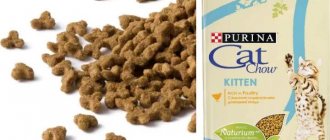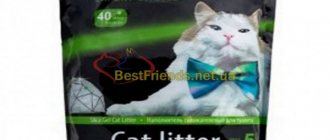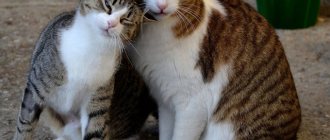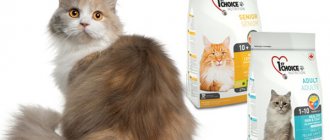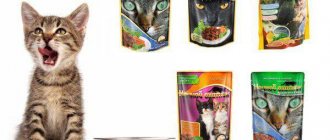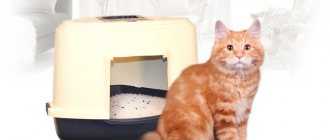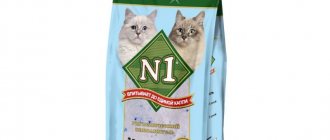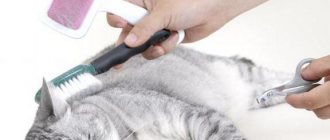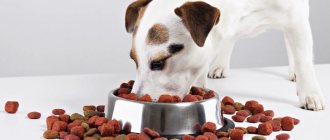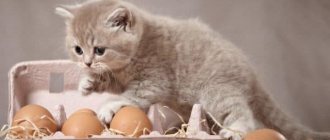Cat behavior when using the toilet
In some cases, the cat completely refuses to use the toilet and does its business in the most unexpected places, while avoiding the tray itself or using it in an unusual way, for example, sleeping in it.
By this, the animal shows that this toilet does not recognize, and most often the reason is dissatisfaction with the filler.
It is impossible to talk to a cat directly and find out its opinion on this issue, but the animal’s behavior can tell a lot to an attentive and caring owner.
Most cats that do not suffer from mental problems do not show dissatisfaction and go to the toilet with any litter. The exception is when the material contains any compounds that cause allergies in the animal. Then it cannot use its toilet purely physically.
In general, a cat’s requirements for litter can be outlined by the following points:
- the material should not contain any flavorings so that nothing distracts the animal’s keen sense of smell;
- the particles should not rustle loudly, knock or make any loud sounds, since cats prefer not to reveal their location to a hypothetical enemy during such an intimate process;
- It should be comfortable for the cat to dig into the tray; it is best if the filler particles are easily mixed and do not stick to the paws or raise dust;
- it is desirable that the material was natural, at least partially.
All cat owners are familiar with their pet's behavior in the toilet. These animals, with varying degrees of energy, dig out a place for themselves to relieve themselves, and then bury them. This behavior is due to the fact that all domestic cats descend from wild ancestors who were forced to take care of their own safety.
Most mammals on our planet navigate the world around them mainly by smell. Good eyesight or acute hearing are also inherent in some of them, but everyone smells smells, drawing from them the information necessary to choose a behavioral strategy. Excrement can tell a lot about an animal to another member of the fauna.
If any animal enters the territory of a wild cat, it can draw conclusions about the gender, age, hormonal background, physical health and mental state of the cat by the smell of feces. But like an animal that cares about its safety and anonymity, the cat prefers not to leave any information about itself, so it carefully buries its excrement.
Domestic cats seem to have no need to perform this ritual and ensure safety, but almost all of them continue to bury their excrement. The cat teaches this to the kitten along with all other skills. It is a fixed behavioral pattern that animals continue to pass on from generation to generation, despite the fact that it has lost its practical value.
In addition, the genes of a cautious predator make cats constantly worry about survival and safety. Even a calm home environment and an always filled bowl does not make them careless; they are always ready to survive in any conditions. And they continue to follow the traditions learned from their mother.
Sometimes cats don't bury their excrement, and that should tell a sensitive owner a lot. There may be several reasons for a change in behavioral pattern. The cat may not hide evidence of his presence for the same reasons that in other conditions he carefully “destroys evidence.” It's about establishing your dominant role.
This behavior is especially common in uncastrated cats who are trying to establish their power in the house in ways available to them.
In most cases, this is due to the fact that there are several animals living in the house, especially if there are two or more mature cats. People call this behavior “marking territory”; it is for this purpose that cats leave their urine, saliva, feces, and rub against corners with glands that secrete odorous substances. This is how they establish their rights.
In some cases, cats stop burying feces for emotional reasons. If there are “clouds gathering” in the house, a difficult emotional situation, cats feel this very keenly. Then their behavior can change greatly, and they stop performing some usual actions, and, on the contrary, begin to behave in an unexpected way.
Quite rarely, but still sometimes cats are simply embarrassed to do their business in front of someone. Of course, the concept of shyness cannot be fully applied to cats. This behavior is due to the fact that when an animal is observed, it does not feel safe.
In such cases, we are not talking about a filler that we don’t like. It may be worth considering purchasing a closed litter box where your pet will be protected from prying eyes.
How to choose a filler
Each person, when choosing a filler, focuses on certain advantages. You should also take into account the pet’s preferences, so if necessary, you need to try a different type of filler and find out what the animal will like.
When choosing, you should always take into account the following parameters, and the owner should make sure that:
- used filler can be easily removed;
- the mixture does not stick to the cat’s paws;
- particles of the filler quickly “lock” and neutralize the smell well, so that the characteristic “aroma” familiar to all cat lovers does not stagnate in the apartment;
- the material does not contain toxic elements in case the animal decides to try it on the tooth;
- the filler is economical and, preferably, not very expensive.
Comparative analysis
When conducting a comparative analysis of which cat litter to choose, it is necessary to take into account the characteristics of the animal and the preferences of the owner. Not all types of fillers are allowed for a small animal. You can determine which kitten litter is best by focusing on the composition of the litter box. In this case, preference should be given exclusively to natural compounds.
If a cat suffers from allergic reactions to litter , it is also advisable to opt for wood options or compositions made from corn processing products.
Corn
If you want to save money, you can give preference to silica gel structures for the tray, which need to be replaced no more than once every 3 weeks. Despite its relatively high cost, such a filler will ultimately save your budget. A kilogram of the substance will last for a long time, regardless of the size of the tray .
How it works
There are two types of filler, differing in their principle of action. The components either absorb secretions and odors, or form dense structures in the form of lumps with urine, which are easily separated from the main mass.
Absorbent filler
Convenient for cats as it quickly absorbs large amounts of liquid. Manufacturers use natural raw materials that are safe for animal health: special types of clay, corn, sawdust, and pulp.
Most manufacturers do not add flavorings, but the composition may include soda, activated carbon or silver ions - these components significantly improve the characteristics of the absorbent filler.
It is inexpensive, but requires more frequent replacement compared to clumping ones, and regular disinfection of the tray itself. There is an advantage to this - with frequent washing, the risk of pathogenic microorganisms multiplying in the contents of the cat litter is much lower.
Important! Opt for an absorbent one if your pet has access to the outdoors (you walk it on a harness or take it to the dacha). Absorbent litter is the best option when there are several cats living in the house.
clumping
This type of brand is more popular, since the clumping filler is convenient for owners. For its production, bentonite is often used, a clay mineral with excellent absorption properties. Wood, paper and some other materials are also used as raw materials.
Why do cat owners love clumping litter? In addition to the obvious advantages - cost-effectiveness and ease of cleaning, some brands have special additives that change color depending on the composition of the urine. So, if the animal is sick, and there are no external symptoms yet, the unusual color of these additives will allow the owner to seek help from a veterinarian in time.
A number of manufacturers include substances that change color when exposed to urine. The purpose of such additives is to clearly define the boundaries of the lump. Therefore, the pet owner can save money by not throwing away clean litter. Many brands contain a variety of fragrances - components that are useless for cats, but pleasant for owners.
Types of fillers
There are many types of fillers. Each of them has its own advantages and disadvantages that are worth studying before heading to the pet store.
Woody
Wood litter for cat litter is formed from small sawdust of various types of wood, which are compressed into granules. The product may consist entirely of wood or include other components.
Cats have a natural habit of burying their waste.
Popular brands include: PrettyCat, Happy Paws and Homecat.
Advantages:
- natural composition;
- different sizes of granules;
- quickly absorbs liquid and prevents the spread of odor;
- low cost.
Minuses:
- pets often scatter granules outside the tray;
- remains on the feet and grid of the tray;
- needs frequent changes.
Mineral
Mineral cat litter is made from zeolite. It removes odor and moisture well.
One of the best representatives of this category is Pussy-Cat Oceanic. The main feature of the product is aromatization. It is recommended to use this litter for caring for adult cats. The product is prohibited for small kittens as it can cause poisoning if swallowed.
The product is easy to remove from the tray, as the waste does not stick to the surface and always remains dry. Mineral filler can be changed much less frequently compared to other types.
Advantages:
- odor elimination;
- fresh aroma that does not repel your pet;
- convenient packaging;
- does not create noise when the cat creates a hole.
Flaws:
- cannot be used for kittens;
- not suitable for disposal through the toilet.
Note! Pussy-Cat litter has antibacterial properties, which provides additional protection for your pet.
Paper
The paper type of fillers is obtained from recycled paper waste. It is one of the best solutions for filling a tray, but is inferior in properties to clay and silica gel.
This is what paper filler looks like
Advantages:
- removes moisture and odor well;
- does not stick to paws and fur;
- suitable for kittens.
Flaws:
- needs to be changed frequently;
- high price;
- rustles when the animal moves in the tray.
Popular brands: A'Mur and NeoSuna.
Corn
Corn litter is the most environmentally friendly, so it can be used for all pets.
Naturel Corn is considered a popular brand. This product is low cost and easy to use. Animals quickly get used to it. The corn product is hypoallergenic, so it is safe not only for pets, but also for people. It can be flushed down the toilet, as the filler does not clog pipes and does not harm the environment.
Advantages:
- easily removed from the tray;
- has a light natural smell;
- pleasant to the touch;
- the residues are often used as fertilizers.
Flaws:
- small packaging volume.
Note! The filler can be changed only 2-3 times a month, which is beneficial and convenient.
Japanese cat litter
Japanese litter is a product based on corn, soy, wood or clay. The products are of high quality. To protect animals, antibacterial components are added to the fillers.
Advantages:
- high quality;
- quickly absorbs and removes odor;
- economical use;
- can be flushed down the toilet in small portions.
Flaws:
- high price;
- Rarely sold in regular pet stores.
The key feature of Japanese products is that the gel pads can be washed, dried and reused.
Carbonic
It is created on the basis of clay and activated carbon. The components absorb odor well, have antibacterial properties and are suitable for all pets.
Advantages:
- quickly eliminates unpleasant odors;
- economical use;
- natural composition;
- low cost.
Flaws:
- quickly absorbs moisture from the air;
- It is not advisable to place a tray with such filler in the bathroom.
Popular brands: Molly Goddle and Fresh Step.
From clay
Clay filler is often based on vermiculite and atapulgite. The quality of the product depends on the type of clay used, so the cost of the product may vary.
Clay products are the most natural for pets, as they resemble soil.
Advantages:
- economical use;
- one package is enough for 3-4 weeks of use;
- safety for animals and humans;
- high hygiene;
- the granules are light in weight.
Flaws:
- dust formation;
- the need to regularly clean the tray;
- cannot be flushed down the toilet.
Important! The product absorbs moisture well and eliminates odor. By type, such products are divided into clumping and absorbent.
Soy
Cat Step Tofu soy litter was introduced in 2021. The product has a natural composition and includes compressed soy fiber. The advantages of such a product are quick odor blocking and moisture absorption. As a result, a lump forms on the surface of the tray, which is easy to dispose of.
A distinctive feature of this product is the ability to flush it down the toilet. However, you should remember that you can wash one lump at a time, and not the entire tray at once. The filler is available in a classic version, as well as with green tea aroma.
Soy products quickly absorb moisture and form lumps that are easily removed from the tray
Silica gel
Silica gel for cats is a polysilicic acid based product. This product has excellent absorbent properties. The materials are produced of proven quality, so safe operation is ensured.
Silica gel filler quickly absorbs moisture and odor, and does not change its structure during use. To keep the toilet clean and fresh, it is recommended to change the composition several times a week.
Advantages:
- economical consumption;
- rapid absorption of moisture;
- safe use;
- little weight.
Flaws:
- high price of the product;
- cannot be used for kittens;
- the granules make loud noises when the pet is in the tray;
- Some products have a specific smell.
Interesting! The gel product is able to change the color of the granules depending on the degree of contamination of the tray, which greatly facilitates the process of replacing the filling.
Where should I put the used filler?
It is not possible to recycle the filler everywhere. Basically, waste is thrown either into the toilet or into the trash bin. Since there is no special place for used granules, these will do for now.
Of course, there is nothing easier than picking up a lump with a scoop and flushing it down the toilet. However, it is worth remembering that only wood type products can be disposed of in the toilet. Disposal is carried out slowly and washed off in small portions, which will avoid clogging in the pipe.
Clay-based litter should only be thrown into a bucket. When a clay granule gets into water, it will swell greatly, so after throwing away the contents of such a tray, you can safely call a plumber. Very soon the sewer pipe will become clogged.
By throwing the contents of the tray into a bucket, you cannot avoid the appearance of an unpleasant odor in the apartment, which will quickly spread from the used granules. It is best to place the contents of the pot in a bag and tie it.
It is not recommended to leave this package even for a short time near the front door. The cat, sensing a familiar aroma, will decide that this place is its new toilet. It will be extremely difficult to wean an animal from this nuisance.
Minuses
Clumping
- Unable to retain unpleasant odors for a long time;
- If not replaced in a timely manner, they turn into small debris and dust;
- Not intended for disposal into sewer.
Absorbent
- When replacing the filling base, an unpleasant odor may appear;
- Rapid contamination of the composition often leads to the animal refusing to go to the tray.
Woody
- Poor odor retention, unlike expensive products;
- When fluid accumulates, it requires frequent replacement, at least once every 4 days;
- Among the granules there are large wood chips that can cause inconvenience to the animal;
- Suitable for cat litter boxes with high sides.
Clay
- Dust formation during prolonged use;
- Significant weight of the product;
- When using clay material, regular cleaning of the tray from waste products is required. Otherwise, the hygienic composition will have to be changed 2 times a week;
- Disposal of material into waste pipes is not permitted.
Mineral
- Complete moistening of the material prevents further absorption of odors;
- Generates a lot of dust;
- Not recommended for use on kittens;
- Less practical compared to other materials;
- More expensive than wood granulate;
- Do not flush into sewer drains.
Silica gel
- High price;
- Not suitable for use on kittens;
- The granules are capable of making loud sounds when pressed and moistened;
- The material has a specific smell.
If it comes into contact with the mucous membrane of an animal, it can cause minor chemical burns.
Corn
The only drawback is the light weight and the appearance of dropouts during active use.
How to pour correctly
The filler is poured into a clean and dry tray in the amount indicated on the package.
Frequency of cleaning the cat litter box
The litter, which absorbs moisture and forms hard lumps, requires cleaning every 2-3 days. Complete replacement of contents is carried out every 5 days. Clumping granules are removed daily and new components are added instead of discarded components, and the contents of the tray are completely replaced every 2-3 weeks. If you carry out cleaning using this system, you don’t have to worry about the appearance of an unpleasant odor in the apartment.
Filler storage
The filler is hygroscopic, that is, the granules have the ability to absorb moisture from the air. Based on this, storage of the product is possible only in dry conditions. Avoid contact of the contents of the package with the chemical or products. It is most convenient to place the filler in a bedside table, which is located near the tray.
This will be convenient when replacing granules and will not allow contact with food or chemicals. No need to worry about the expiration date. When purchasing several packages, it is worth considering that proper storage will ensure an unlimited shelf life .
Which brand of cat litter is best to choose?
Such pet products made in Japanese, Chinese, American, German and Russian are very popular. The competition among them is extremely high, but they can withstand it with dignity, leaving behind other companies, the following brands and firms:
- Pussy-Cat is a brand owned by the Kis Pis Group, which sells hygienic litter for pets. The company began its activities in 1987. Its products are environmentally friendly, recognized as safe for animals and are not very expensive.
- Effem GmbH – in this rating it is represented by Catsan Ultra Plus cat litter. This is a German manufacturer that guarantees high quality, safety and ease of use of its products. It has excellent absorption capacity, which makes its use comfortable for animals.
- Catsan is an American brand whose products are manufactured in Germany. Its range includes clay and mineral type fillers - clumping and absorbent. They come in thick cardboard packages with handles and cost slightly above average.
- N 1 – premium cat litter at an affordable price, produced in Russia. The brand's product range includes absorbent and clumping fillers, mainly silica gel. Cats respond well to them, do not walk past the toilet and do not spread its components around the apartment.
- Cat Step - the owner of the brand is the largest manufacturer of pet products on the Russian market, Amma company. Its products are created for hygienic use of the toilet by cats, to eliminate unpleasant odors in the litter box and eliminate them in the apartment. It is non-toxic, does not cause allergies and does not stick to the paws of pets.
- Zoonic is a brand that attracts interest with a wide range of pet products, including litter tray fillers. It is owned by one of the oldest on the Russian market. The range includes wood and silica gel, clumping and absorbent fillers. Most of them are available in small packages of up to 6 kg.
- Barsik is a registered trademark that has been operating on the Russian market since 1991. Its products are distinguished by high quality, hypoallergenic, safe and reasonable prices. They reflect the smell of cat urine well and prevent it from spreading throughout the apartment or house.
The most budget-friendly brands on the market are Zoonik and Barsik, and the quality of their products is not inferior to those included in the premium class category.
Rating of the best wet food for cats
Rating of the best cat litters
When compiling this TOP and in selecting good cat litter, customer reviews and veterinarian opinions played a huge role.
These are the parameters we also paid attention to when analyzing the characteristics of the product:
- Type – wood, silica gel, corn, mineral or clay;
- Packaging volume and its convenience;
- Natural composition and safety of use;
- Reaction of cats to raw materials;
- Type – absorbent or clumping;
- Ease of use – can it be flushed down the toilet, is it easy to clean with a spatula, etc.;
- Natural aroma and protection against urine odor;
- Which cats are suitable for – by age and breed;
- Economical consumption and replacement frequency.
A special selection criterion was the price-quality ratio of the fillers, the brand under which they are produced, and their availability for sale.
The best cat carriers according to customer reviews
How to use it correctly
Immediately after purchasing the tray, you need to wash it and wipe it dry to remove the smell of plastic. How to use it correctly
How to properly use each specific cat litter is written in detail on the packaging. You just need to follow the instructions.
The filler should be poured into the tray in a fairly thick layer, at least 3-5 cm, clumping compounds - at least 7 cm. After the cat goes to the toilet, remove the lumps from the container, shake lightly, and stir its contents. The tray should be filled to the required level as needed. Ideally, this should be done every day.
Many owners have trained their cats to use a litter box with a grid or mesh, without filler. The main inconvenience of this method is that in this case you will have to clean the container several times a day. Otherwise, the aromas will spread throughout the apartment.
In addition, your pet may urinate on the carpet, sofa or slippers if it is not satisfied with the degree of cleanliness of the cat litter box. So using a container without filler is not a good idea.
A method that combines a grid in a tray and a filler has proven itself well. It is poured onto the bottom. In this case, the grill will have to be washed at least once a day.
The best wood litter for cat litter
Here it is worth taking a closer look at two fillers from the famous brands “Barsik” and “Zoonik”.
Barsik Natural 4.54 l
Barsik is the best wood filler that pleases even the most picky cats. It consists of small soft granules that are comfortable for the animal’s delicate paws. The material is environmentally friendly and does not harm four-legged animals, is easily distributed throughout the tray, absorbs cat excrement well and thereby reduces the unpleasant odor. Its prevention is also helped by adding special ingredients to the composition. The raw materials are safe for humans and nature, being biodegradable.
Advantages
- Cheapness;
- High quality;
- Can be flushed down the toilet;
- Does not clump;
- Stays dry;
- Suitable for small kittens.
Flaws
- Not sold everywhere;
- Can be spread on cats' paws.
Barsik Natural is sold in a large 4.5 liter paper bag; it does not have the usual handle, so carrying the bag is not very convenient.
Zoonic Wood 5 l
I have been using this litter for more than six months, it does not clump, it is suitable for litter boxes of different sizes and cats of all breeds...Expert opinion
This wood filler is in no way inferior to its predecessor in the rating. Its use is comfortable for cats and humans; the granules perfectly absorb urine, have a pleasant aroma and cover up its odor. It belongs to the premium class due to its hygiene and environmental friendliness; it is made from natural raw materials. The granules are small in size, but at the same time they do not stick together and are not spread throughout the house. One package sells 5 kg.
Advantages
- Cats like to dig holes in it;
- It is carefully raked with its paws and does not fly apart;
- It does not compact, which allows you to create volume;
- Convenient packaging with handles that does not get wet;
- Inexpensive.
Flaws
- Sometimes there is a bit of "sawdust".
Features of mineral fillers
You can also see another filler on the shelf in a pet store - mineral absorbent.
It is made on the basis of minerals with a porous structure.
From the instructions on how to use it, it is clear that it is replaced a little less often than wood - once a week is enough.
The granules absorb liquid well and prevent the spread of unpleasant odors.
They do not stick to paws and do not spread around the house.
As for the downsides, the mineral absorbent filler is dusty.
Important! When cleaning, mineral fillers should not be flushed down the toilet to avoid clogging.
Absorbent filler neutralizes odors
Its second type is clumping filler.
Quartz sand, chalk, and bentonite are used for its production.
It perfectly absorbs moisture and absorbs unpleasant odors.
The difference between clumping compounds is that when liquid gets in, they form a dense lump that is easy to remove from the tray.
The remaining granules will be clean; complete replacement is carried out as lumps accumulate.
Particles of granules do not stick to the pet’s paws and do not get stuck between the pads.
It is worth noting that the price of clumping filler is 3-4 times higher than the cost of absorbent filler.
Granules are also prone to dust, which is important to consider when pouring the mixture into a tray.
It is primarily suitable for owners of one cat.
If there are several furry pets in the house, the owners will have to constantly pick out the resulting lumps.
The composition is not recommended for small kittens either, due to their curiosity and desire to check everything for edibility.
Therefore, if the cat has recently given birth , the choice of litter will have to be reconsidered.
Important! The optimal layer for lump formation is 8 cm.
The Best Clay Cat Litters
This type of filler is inexpensive and can be used in the tray for a long time without replacement, but it retains the odor a little worse than wood filler.
Catsan Ultra Plus 5 l
This cat litter is highly rated for its ability to keep your home clean. When wet, the raw materials do not stick to the cats' paws and do not spread across the floor. In case of ingestion of particles, nothing threatens the pet’s health, since the material is natural and does not cause intoxication. Wet lumps can be easily removed with a spatula; there is no need to completely replace the contents of the tray. The composition of Catsan Ultra Plus is close to the most natural, so four-legged animals stop walking past the toilet.
Advantages
- Small granule size;
- Softness of raw materials;
- When combined with water, they form compact pieces, which makes cleaning in the tray easier;
- Natural composition;
- Does not cause allergies.
Flaws
- Small volume.
The bag in which the Catsan Ultra Plus filler is packed is made of thick paper and equipped with a convenient handle for comfortable carrying.
The Best Silica Gel Litters for Cat Litters
The 2 best silica gel cat litters were included in this category. Each of them is safe and easy to use.
N1 Crystals 30 l
N1 Crystals cat litter is one of the best because it is environmentally friendly, safe and absorbs a large amount of moisture. Due to this, one load of product in the tray lasts for several days, which allows you to save money. It has a normal smell to which the animal responds well and does not repel them due to its softness. Silica gel granules do not stick to the pet's paws and fur and do not injure its tissues. Since it contains special components, the appearance of an unpleasant odor in the house is eliminated.
Advantages
- Economical to use;
- Hypoallergenic;
- Dust does not appear when filling the tray;
- Easy to clean toilet;
- Non-toxic.
Flaws
- Do not flush down the toilet;
- Tough if the animal wants to chew it;
- Not suitable for small kittens.
Cat Step Silica Gel
This cat litter is regularly included in ratings of the best among silica gel ones due to the optimal combination of high quality and low cost. It is made from a specially prepared gel that is safe for adult cats. It can not be changed for a long time, since the raw material absorbs moisture well and suppresses the unpleasant odor of urine. Cats have no difficulty burying their excrement, but it may create some noise when creating the hole. Cat Step is manufactured using European technologies and is recommended for use by veterinarians.
Advantages
- Large volume – 15.2 l;
- Convenient packaging;
- Lasts a long time;
- Contamination is easily removed;
- Does not stain cats' fur or paws;
- Does not cause allergies.
Flaws
- Not sold everywhere;
- It is better not to use for small kittens.
When to change
The need to change cat litter directly depends on the type of litter used:
- wood fillers need to be changed once every few days, as they tend to crumble into sawdust;
- clay and mineral toilets are changed once every 7 days;
- silica gel is changed once every 2-3 weeks.
Sterilization of cats: options at what age is best to do it
The above timings assume that solid waste products will be disposed of immediately after defecation.
Something to remember! Before adding a new layer of filler, the tray must be washed with laundry soap or odorless detergent.
The need to change the tray also depends on the age of the animal. Small kittens have a much faster metabolism, so they go to the toilet more often.
If the toilet is not cleaned regularly, pets will choose other places for their needs.
Proper care of a cat's litter box will ensure a quiet life not only for the animal, but also for humans.
Can I flush it down the toilet?
Any tray filler requires special disposal. Wood pellets can be placed into the toilet in small portions, but this should be done as rarely as possible. It is necessary to wash off such a product with a large amount of water, since the usual volume of water in the tank is not enough to soak the granules.
It is strictly forbidden to wash off large portions of clumping products, such as clay products. It is permissible to put only fresh lumps of solid daily waste into the toilet. When you try to empty the entire contents of the tray, there is a risk of clogging the pipes, which are then very difficult to clean.
Silica gel fillers should not be washed off either, as they do not dissolve in water.
Advantages and disadvantages of various types of fillers
Let's look at the pros and cons of different types of fillers.
The mixture may retain its structure when excrement comes into contact with it, or it may form into clumps. Lump-forming fillers, when urine comes into contact with them, form into conglomerates that are easily removed from the tray, without throwing away unused filler.
Absorbent materials must be completely replaced.
The advantages of clumping filler include:
- economical consumption (you can throw out only lumps and solid excrement as needed, after which you can pour a little filler into the tray);
- these types of fillers retain odor well;
- convenience (using a special spatula to remove lumps from the tray is very easy).
Such fillers are very convenient if there is only one pet in the house. If several cats live together, it is better to choose absorbent litter. They are made from environmentally friendly materials, are safe, eliminate odor and moisture, retaining them while they are in the tray.
However, very clean cats may refuse to reuse the litter box, even if not all of the litter has been used, because it does not hold the odor well enough.
Let's look at the pros and cons of fillers made from various materials.
Mineral
This material is very common, as it has undoubted advantages and a relatively low price (depending on the manufacturer). It retains odor well and compares favorably with sawdust in this property. For the production of mineral filler, raw materials of both natural origin and synthetic materials are used.
Cheaper mineral mixtures are very dusty, as the granules rub against each other, forming very small particles. Such fillers are not recommended for use on kittens and animals prone to allergic reactions, as dust can harm them. And digging around in a dusty column is not very pleasant. More expensive and high-quality products have greater density and generate less dust.
Silica gel
This material is the most innovative, practical, but also expensive. It is the latter quality that prevents such fillers from displacing all other types of this product from the market. Otherwise, it is the most economical and fairly safe material.
Silica gel fillers belong to the absorbent class, and you have to clean the tray infrequently: once every few days. You can completely change the filler every two or three weeks.
Among the disadvantages, we can note the fact that not all cats like the sounds that the gel particles make when the animal digs in the tray. The material may also have an odor that is invisible to humans, but can be detected by the sensitive nose of a cat.
The cat may not like the smell of his litter box.
The material has been used for the manufacture of cat litter relatively recently, so there is no reliable information about its safety.
How are fillers classified according to their principle of action?
If you pay attention to the structure of the filler, you can distinguish two groups:
- absorbent;
- clumping.
The absorbent composition does not change its structure after getting wet.
As you use it, liquid accumulates in the lower layers, and this affects how you use it.
This type of cat litter requires complete replacement approximately 2 times a week.
If this is not done in a timely manner, an unpleasant odor will begin to emanate from the tray.
It will be necessary to replace the layer of granules more often if there are several cats in the house.
The composition can be purchased relatively cheaply at pet stores.
Mineral filler consists of small granules
Clumping cat litter is different in that when liquid gets on it, it rolls into hard lumps.
This is reflected in the recommendations on how to use it.
To keep it clean, simply remove these clumps from the tray daily and add a fresh layer of granules.
In order for the clumping filler to live up to its name, it should be poured in a layer of at least 8 cm.
However, it is unlikely that you will be able to purchase a high-quality composition cheaply.
How to choose the right litter for cats?
Choosing a litter box for your cat is more difficult than it might seem at first. Especially today, when there are several dozen different brands in stores. To make the process a little easier, I suggest you familiarize yourself with how to choose cat litter - the main points that are worth considering:
- First of all, it is important to take into account the cat’s “opinion”. Buy several different types of litter and try adding them one at a time. By the reaction of the purr, you can see which option he likes best. Sometimes cats, for some reason, refuse to go to the toilet with, for example, wood filler, but they use a tray with mineral filler with pleasure.
- Focus on the age of the animal - granules that are too large are not suitable for small kittens.
- Not all cats like the flavorings that are added to litter. So if you want your cat's litter box to smell like lavender or the sea breeze, don't expect your pet to share your desires.
Which filler is better?
As you can see, today there are many types of filler. If the apartment has one tray for several cats, it is better to purchase absorbent granules. If the cat is alone, use a litter that rolls into clumps.
For cats with long hair, I recommend taking a closer look at large granules. They do not stick to the paws or fur, so the pet will not carry them around the rooms. But for small kittens it is better to buy litter with small granules. Large pieces are difficult for children to bury. If you notice that the kitten is trying to eat the litter, it is better to temporarily put old newspapers in the tray. Over time, this “food” interest in cats fades away.
Also read: Cat carrier – which one is better to choose?
The only way to find out which litter is best for a cat is by trial. Buy several small packages and try different products one at a time, monitoring your cat's behavior. Believe me, if your fluffy doesn’t like the option you choose, he will immediately let you know about it by ignoring the tray. But as soon as you find the right filler, you can be sure that the toilet will be clean and have a pleasant aroma.
Customer Reviews
If you are still undecided on the type of filler, try reading reviews from other furry owners. As a rule, they already have experience in toilet training a cat, which was gained through trial and error. Here's what pet owners say about litter trays:
Sources
- https://MrKot.com/kakoi-napolnitel-vybrat
- https://kotoholik.com/tovary-dlia-koshek/napolniteli-dlya-tualetov.html
- https://gafki.ru/koshki/napolnitel-dla-kosacego-tualeta.html
- https://vash.market/dom-i-dacha/dlya-zhivotnyh/koshachij-napolnitel.html
- https://vyborexperta.ru/zhivotnye/luchshie-napolniteli-dlya-koshachego-tualeta/
- https://catmolly.com/napolniteli-dlya-koshek/
[collapse]
